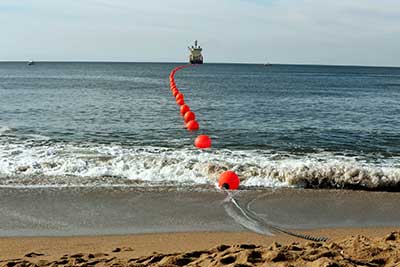Date: 08/04/2023
Relevance: GS-2: Bilateral, Regional and Global Groupings and Agreements involving India and/or affecting India’s interests; Effect of Policies and Politics of Developed and Developing Countries on India’s interests.
Key Phrases: USA-China, Under-sea Fiber-optic Internet Cable Network, EMA Project, Secure and Stable Internet, Hegemonist Approach, Constructivist Approach, Tech war, SeaMeWe-6 cable.
Context:
- Chinese state-owned telecom firms are developing a $500 million
undersea fiber-optic internet cable network that would link Asia, the
Middle East and Europe to rival a similar US-backed project.
- The plan is a sign that an intensifying tech war between Beijing and Washington risks tearing the fabric of the internet.
Key Highlights:
- China’s three main carriers - China Telecommunications Corp.
(China Telecom), China Mobile Limited and China United Network
Communications Group Co. Ltd(China Unicom)—are mapping out one of the
world’s most advanced and far-reaching subsea cable networks.
- Known as EMA (Europe-Middle East-Asia), the proposed cable would link Hong Kong to China’s island province of Hainan, before snaking its way to Singapore, Pakistan, Saudi Arabia, Egypt and France.
- The cable, which would cost approximately $500 million to complete, would be manufactured and laid by China’s HMN Technologies Co. Ltd, a fast-growing cable firm whose predecessor company was majority-owned by Chinese telecom giant Huawei Technologies Co. Ltd.
USA-China Tech War:
- The USA government is concerned about Beijing eavesdropping on internet data which has successfully thwarted a number of Chinese undersea cable projects abroad over the past four years.
- Washington has also blocked licenses for planned private subsea
cables that would have connected the US with the Chinese territory of
Hong Kong, including projects led by Google LLC, Meta Platforms, Inc and
Amazon.com Inc.
- Undersea cables carry more than 95% of all international internet traffic.
- These high-speed conduits for decades have been owned by groups of telecom and tech companies that pool their resources to build these vast networks so that data can move seamlessly around the world.
- But these cables, which are vulnerable to spying and sabotage, have
become weapons of influence in an escalating competition between the US and
China.
- The superpowers are battling to dominate the advanced technologies that could determine economic and military supremacy in the decades ahead.
- The China-led EMA project is intended to directly rival another cable
currently being constructed by US firm SubCom LLC, called SeaMeWe-6
(Southeast Asia-Middle East-Western Europe-6), which will also connect
Singapore to France, via Pakistan, Saudi Arabia, Egypt, and half a dozen
other countries along the route.
- The consortium on the SeaMeWe-6 cable—which originally had included China Mobile, China Telecom, China Unicom and telecom carriers from several other nations—initially picked HMN Tech to build that cable. But a successful US government pressure campaign flipped the contract to SubCom last year.
- The US blitz included giving millions of dollars in training grants to foreign telecom firms in return for them choosing SubCom over HMN Tech.
- The US commerce department also slapped sanctions on HMN Tech in
December 2021, alleging the company intended to acquire American technology
to help modernize China’s People’s Liberation Army.
- That move undermined the project’s viability by making it impossible for owners of an HMN-built cable to sell bandwidth to US tech firms, usually their biggest customers.
Beginning of EMA Project:
- China Telecom and China Mobile pulled out of the project after SubCom won the contract last year.
- These firms, along with China Unicom, began planning the EMA cable.
- The three state-owned Chinese telecom firms are expected to own more than half of the new network, but they are also striking deals with foreign partners.
- The Chinese carriers signed separate memoranda of understanding with four telecoms, France’s Orange SA, Pakistan Telecommunication Company Ltd (PTCL), Telecom Egypt and Zain Saudi Arabia, a unit of the Kuwaiti firm Mobile Telecommunications Company K.S.C.P.
Way Forward:
- Large undersea cable projects typically take at least three years to move from conception to delivery.
- The Chinese firms are hoping to finalize contracts by the end of the
year and have the EMA cable online by the end of 2025.
- The cable would give China strategic gains in its tussle with the
United States.
- First, it would create a super-fast new connection between Hong Kong, China and much of the rest of the world, something Washington wants to avoid.
- Second, it gives China’s state-backed telecom carriers greater reach and protection in the event they are excluded from US-backed cables in the future.
- The cable would give China strategic gains in its tussle with the
United States.
- By supporting an open and secure internet, countries should prioritize security and privacy in wireless networks, terrestrial and undersea cables, satellites, cloud services and data centres.
Source: Live-Mint
Mains Question:
Q. “Increasing footprint of China in sub-sea internet cable networks presents challenges to the diplomacy of USA.” Critically analyze the statement. (250 Words).






















